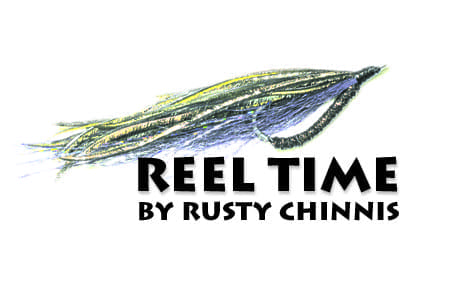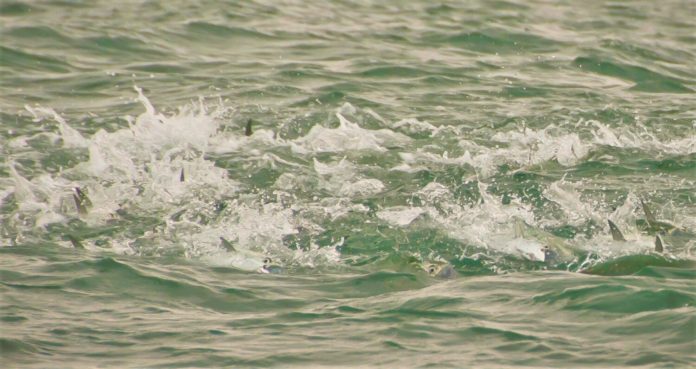little tunny. – Rusty Chinnis | Sun
Fall is in the air. Most of our windows and doors are still closed and the AC is on, but the light and the cooling mornings hold the promise of change.
This is a change ushered in by cooler temperatures, shorter days and arguably some of the best nearshore angling opportunities we have. As water temperatures drop, schools
of bait should migrate inshore with pelagic species like kingfish, Spanish mackerel, false albacore (little tunny), cobia and tripletail hot on their trail.
Now is a great time to prepare for the fall season, getting tackle in order at home and keeping an eye to the sky for diving birds and the water for breaking fish when you’re on the water. All these species will take live bait, lures or flies and can be caught on spinning, bait casting or fly tackle. Except for larger king mackerel and cobia, most can be landed with light tackle, which adds to the challenge.
 Rigging will depend on the species you’re targeting. Since it’s possible to encounter so many different species in a single outing, multiple outfits are a good idea. Rigging options include wire, monofilament, long shanked hooks, or a combination. It’s possible to catch a kingfish or Spanish mackerel without wire, but your odds aren’t good. Most species shy away from wire, especially in clear water and when the sun is high. That’s when it’s time to switch to a long shank hook or a heavy (60-pound) monofilament leader. Even then, it’s possible to get cut off but you’ll get more action. When using wire, an 8- to 12-inch trace can be tied to monofilament using an Albright special knot (best) or a swivel. If you use a swivel, use black as opposed to a silver one to prevent fish from mistaking it for forage. American Fishing Wire makes a product called Surflon Micro Supreme that is extremely flexible and kink resistant. This wire can be knotted to your lure, hook or fly like monofilament. It also provides greater flexibility and less stretch than monofilament. Umpqua makes a product that’s ideal for fly anglers. Their Re-Twistable Haywire Twist wire is reusable and will allow you to change flies in a snap. This is the quickest and most painless system to rig wire for toothy fish. It’s safe to switch to wire under low light conditions like early morning, overcast days and late in the day.
Rigging will depend on the species you’re targeting. Since it’s possible to encounter so many different species in a single outing, multiple outfits are a good idea. Rigging options include wire, monofilament, long shanked hooks, or a combination. It’s possible to catch a kingfish or Spanish mackerel without wire, but your odds aren’t good. Most species shy away from wire, especially in clear water and when the sun is high. That’s when it’s time to switch to a long shank hook or a heavy (60-pound) monofilament leader. Even then, it’s possible to get cut off but you’ll get more action. When using wire, an 8- to 12-inch trace can be tied to monofilament using an Albright special knot (best) or a swivel. If you use a swivel, use black as opposed to a silver one to prevent fish from mistaking it for forage. American Fishing Wire makes a product called Surflon Micro Supreme that is extremely flexible and kink resistant. This wire can be knotted to your lure, hook or fly like monofilament. It also provides greater flexibility and less stretch than monofilament. Umpqua makes a product that’s ideal for fly anglers. Their Re-Twistable Haywire Twist wire is reusable and will allow you to change flies in a snap. This is the quickest and most painless system to rig wire for toothy fish. It’s safe to switch to wire under low light conditions like early morning, overcast days and late in the day.
One of the most effective ways to find schooling fish in the fall is to look for surface action and diving birds in the inshore Gulf waters. But don’t assume fish aren’t present if there are no outward signs of them. Predators can often be found around structures, reefs and wrecks that attract bait.
When you find feeding fish, you can approach them by trolling, drifting or with the use of a trolling motor. Whatever method you employ, never let your boat pass through or get too close to the action. With more and more boats and anglers pursuing feeding fish, they are likely to sound and move away. The best bet is to stay outside the action but within casting distance. If trolling, make wide turns so only your lures pass through the action.
Live bait anglers target schooling fish in several ways. By anchoring up current from a likely area, they may deploy a chum bag and then toss wounded live baits to draw fish into casting range. This can be an extremely effective method. Those that prefer artificial lures find spoons particularly effective as well as jigs like the DOA CAL or the Berkley Gulp. One of the most exciting and effective types of lures are topwater models like the MirroLure Top Dog, the Heddon Zara Spook or Rapala Saltwater Skitter Pop. Not only is the strike visual and often explosive, but their action can attract target species.
Fly fishing is also an effective and exciting way to target fall species from cobia to tripletail, Spanish mackerel and even kingfish. The same rigging applies and topwater flies like the Crease fly or Garthside Gurgler can produce some memorable strikes. Clouser Deep Minnows are also a great choice for Spanish mackerel and false albacore. This is a good time of the year to have a 10- or 11-weight rod rigged with a big black fly should a migrating cobia make an appearance.
Whatever your fishing style, take advantage of the great action you’ll find in area waters this fall. If you’re new to the game, consider hiring a guide. This is a great way to learn the ropes and a great value when shared with a friend. Good fishing!
Credit: Source link































